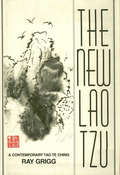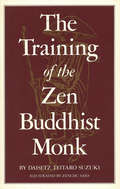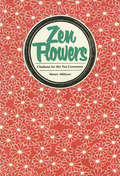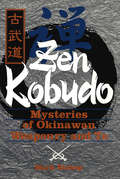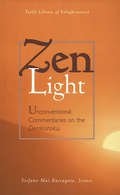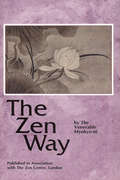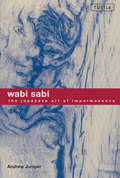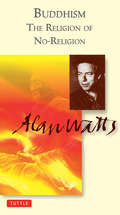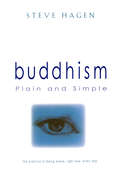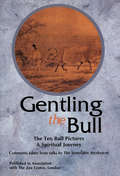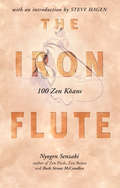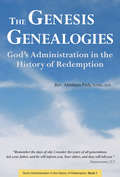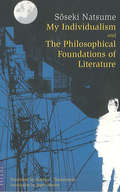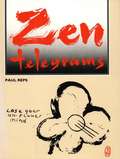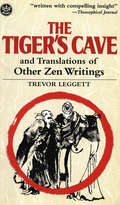- Table View
- List View
The New Lao Tzu
by Ray GriggA new interpretation of the Tao Te Ching, this book is a celebration of the Way of Harmony and Balance. Ray Grigg transforms what has been traditionally called the Tao Te Ching, what he calls the Lao Tzu, from the mysterious to the meaningful. He accomplishes this by abandoning the historical convention of a literal reading of the Chinese texts. The result is a poetic expression of ancient wisdom in a language that readers can approach directly. The wisdom of the Lao Tzu rests in its ability to tease confusion into insight that is beyond the confinement of intellectual understanding. Beautifully illustrated with ink drawings by Bill Gaetz, The New Lao Tzu demonstrates that living the wisdom of the Lao Tzu requires more instinct than reason, more intuition than argument.
The Training of the Zen Buddhist Monk
by Daisetz Teitaro SuzukiDaisetz Teitaro Suzuki's The Training of the Zen Buddhist Monk invites you to step inside the mysterious world of the Zendo, where monks live their lives in simplicity.This is perhaps the best introduction to Zen and the life of the Zen monk. By means of a direct and succinct description of the training that a Zen Buddhist monk undergoes, Dr. Suzuki has given us the most precise picture possible of Zen in life.The forty-three illustrations give a unique value to the book. The artist, Zenchu Sato has depicted here the record of his own experiences in going through all the disciplinary measures pertaining to the life of Zen.As author, Dr. Suzuki said, "Zen ought to be studied not only in its theoretical aspects, as a unique product of the Oriental mind, but in its practical aspect as it is to be seen in the Zendo life. This is the chief motive for my writing this book."
The Training of the Zen Buddhist Monk
by Daisetz Teitaro SuzukiDaisetz Teitaro Suzuki's The Training of the Zen Buddhist Monk invites you to step inside the mysterious world of the Zendo, where monks live their lives in simplicity. Suzuki, best known as the man who brought Zen classics to the West, sheds light on all phases of a monk's experience, from being refused admittance at the door to finally understanding the meaning of one's "koan". Suzuki explains the initiation ceremony, the act of begging, and the life of prayers, meditation, and service.
The Training of the Zen Buddhist Monk
by Daisetz Teitaro SuzukiDaisetz Teitaro Suzuki's The Training of the Zen Buddhist Monk invites you to step inside the mysterious world of the Zendo, where monks live their lives in simplicity. Suzuki, best known as the man who brought Zen classics to the West, sheds light on all phases of a monk's experience, from being refused admittance at the door to finally understanding the meaning of one's "koan". Suzuki explains the initiation ceremony, the act of begging, and the life of prayers, meditation, and service.
Zen Flowers: Chabana for the Tea Ceremony
by Henry MittwerThis Zen flower arranging book teaches the delicate art of Japanese Chabana--the precursor to ikebana.<P><P>Up to now, with the exception of Okakura Kakuzo's excellent account of flowers used in the art of Chanoyu in his delightful The Book of Tea, almost nothing has been available on the subject. To my knowledge, the present volume is the only book written in English that is wholly devoted to the special form of flower arrangement called Chabana.Chabana is a type of flower arrangement that originated in the tea room . Chabana is not only for decoration, for symbolic representation, or for abstract expression of the self. 2,500years ago, Chabana has something in common with one of Shakyamuni Buddha's sermons. Buddha lightly picked a single bloom from a basketful of flowers offered to Him by one of the multitude who came to hear His sermon. Buddha slowly, silently, held up the flower before the congregation. Among the gathering was one of His disciples, Mahakasyapa, who gently smiled as he apprehended the Buddha's gesture. Chabana may not be a flower arrangement having a Zen-like mission, but it certainly is a flower arrangement appreciated by a mind nourished with the Zen principles of simplicity and directness.
Zen Kobudo
by Mark BishopKobudo, the famous armed Okinawan fighting art that utilizes common farming implements in combat, and Te, the ancient Okinawan art of armed and unarmed combat, are two of the world's most widely practiced yet least-understood martial arts. This book studies the individual Kobudo and Te systems as they are practiced in Okinawa today and discusses their various histories and the lives of the masters who have most influenced them. Spiritualism in the Okinawan arts is also covered in detail, as the author masterfully describes the mix of Zen and native beliefs that are vital to these arts, yet a component that has been all but ignored by previous researchers. In addition, this is the first work to discuss anthropological theories on Okinawa and the development of fighting arts there from the Stone Age. This complete and wide-ranging study of Okinawan weaponry, history, and training is the ultimate guide to these important fighting arts.
Zen Kobudo
by Mark BishopKobudo, the famous armed Okinawan fighting art that utilizes common farming implements in combat, and Te, the ancient Okinawan art of armed and unarmed combat, are two of the world's most widely practiced yet least-understood martial arts. This book studies the individual Kobudo and Te systems as they are practiced in Okinawa today and discusses their various histories and the lives of the masters who have most influenced them. Spiritualism in the Okinawan arts is also covered in detail, as the author masterfully describes the mix of Zen and native beliefs that are vital to these arts, yet a component that has been all but ignored by previous researchers. In addition, this is the first work to discuss anthropological theories on Okinawa and the development of fighting arts there from the Stone Age. This complete and wide-ranging study of Okinawan weaponry, history, and training is the ultimate guide to these important fighting arts.
Zen Light
by Stefano Mui BarragatoThe Denkoroku, or "Record of Transmitting the Light," contains the enlightenment stories of the earliest Zen ancestors. In Zen Ught, the author comments on this Buddhist classic, which he studied as part of his own advanced Zen training. Sensei Barragato brings the varied experiences of his life and his studies in Catholicism and Quaker practice to the teachings of Zen Buddhism, making these commentaries at once off-beat, refreshing, and revealing. He touches on the major issues that affect our lives, making thisbook of interest to both the beginning as well as the advanced student of Zen.
Zen Light
by Stefano Mui BarragatoThe Denkoroku, or "Record of Transmitting the Light," contains the enlightenment stories of the earliest Zen ancestors. In Zen Ught, the author comments on this Buddhist classic, which he studied as part of his own advanced Zen training. Sensei Barragato brings the varied experiences of his life and his studies in Catholicism and Quaker practice to the teachings of Zen Buddhism, making these commentaries at once off-beat, refreshing, and revealing. He touches on the major issues that affect our lives, making thisbook of interest to both the beginning as well as the advanced student of Zen.
The Zen Way
by Myokyo-NiMyokyo-ni is the Buddhist name of Dr. Irmgard Schloegl, who directs the Zen center Shobo-an in London. Here she seeks to describe Zen and Zen practice from a few different approaches, presenting basic Buddhist thought as well as an overview of the life of the historical Buddha. She gives a section on training in a Japanese Rinzai Zen monastery-perhaps the most unique feature of the book, although her presentation is rather impersonal. Her final section, "Fundamentals," is rambling and might have benefited from further organization and subdivision. The author's style throughout is decidedly Western, with a psychological, philosophical tone that does not sit comfortably with some of the more esoteric writings in the field. For an introduction to the subject, there are better sources, such as Robert Aitken's Taking the Path of Zen (Farrar, 1982). For serious students of Zen, there are valuable insights hidden in the sometimes difficult but heartfelt analyses scattered through the book.
The Zen Way
by Myokyo-NiMyokyo-ni is the Buddhist name of Dr. Irmgard Schloegl, who directs the Zen center Shobo-an in London. Here she seeks to describe Zen and Zen practice from a few different approaches, presenting basic Buddhist thought as well as an overview of the life of the historical Buddha. She gives a section on training in a Japanese Rinzai Zen monastery-perhaps the most unique feature of the book, although her presentation is rather impersonal. Her final section, "Fundamentals," is rambling and might have benefited from further organization and subdivision. The author's style throughout is decidedly Western, with a psychological, philosophical tone that does not sit comfortably with some of the more esoteric writings in the field. For an introduction to the subject, there are better sources, such as Robert Aitken's Taking the Path of Zen (Farrar, 1982). For serious students of Zen, there are valuable insights hidden in the sometimes difficult but heartfelt analyses scattered through the book.
Wabi Sabi
by Andrew JuniperDeveloped out of the aesthetic philosophy of cha-no-yu (the tea ceremony) in fifteenth-century Japan, wabi sabi is an aesthetic that finds beauty in things imperfect, impermanent, and incomplete. Taken from the Japanese words wabi, which translates to less is more, and sabi, which means attentive melancholy, wabi sabi refers to an awareness of the transient nature of earthly things and a corresponding pleasure in the things that bear the mark of this impermanence. As much a state of mind--an awareness of the things around us and an acceptance of our surroundings--as it is a design style, wabi sabi begs us to appreciate the simple beauty in life--a chipped vase, a quiet rainy day, the impermanence of all things. Presenting itself as an alternative to today's fast-paced, mass-produced, neon-lighted world, wabi sabi reminds us to slow down and take comfort in the simple, natural beauty around us.In addition to presenting the philosophy of wabi-sabi, this book includes how-to design advice--so that a transformation of body, mind, and home can emerge.Chapters include:History: The Development of Wabi SabiCulture: Wabi Sabi and the Japanese CharacterArt: Defining AestheticsDesign: Creating Expressions with Wabi Sabi MaterialsSpirit: The Universal Spirit of Wabi Sabi
Wabi Sabi
by Andrew JuniperWabi sabi, the quintessential Japanese design aesthetic, is quickly gaining popularity around the world, as evidenced by recent articles in Time, The Chicago Tribune and Kyoto Journal. Taken from the Japanese words wabi, which translates to less is more, and sabi, which means attentive melancholy, wabi sabi refers to an awareness of the transient nature of earthly things and a corresponding pleasure in the things that bear the mark of this impermanence. As a design style, wabi sabi helps us to appreciate the simple beauty in imperfection--of a chipped vase or a rainy day, for example.
Wabi Sabi
by Andrew JuniperWabi sabi, the quintessential Japanese design aesthetic, is quickly gaining popularity around the world, as evidenced by recent articles in Time, The Chicago Tribune and Kyoto Journal. Taken from the Japanese words wabi, which translates to less is more, and sabi, which means attentive melancholy, wabi sabi refers to an awareness of the transient nature of earthly things and a corresponding pleasure in the things that bear the mark of this impermanence. As a design style, wabi sabi helps us to appreciate the simple beauty in imperfection--of a chipped vase or a rainy day, for example.
Buddhism the Religion of No-Religion
by Alan WattsIn this dynamic series of lectures, Alan Watts takes us on an exploration of Buddhism, from its roots in India to the explosion of interest in Zen and the Tibetan tradition in the West. Watts traces the Indian beginnings of Buddhism, delineates differences between Buddhism and other religions, looks at the radical methods of the Mahayan Buddhist, and reviews the Four Noble Truths and The Eightfold Path.
Buddhism Plain and Simple
by Steven HagenBuddhism Plain and Simple offers a clear, straightforward treatise on Buddhism in general and on awareness in particular.When Buddha was asked to sum up his teaching in a single world, he said, "Awareness." The Buddha taught how to see directly into the nature of experience. His observations and insights are plain, practical, and down-to-earth, and they deal exclusively with the present.Longtime teacher of Buddhism Steve Hagan presents the Buddha's uncluttered, original teachings in everyday, accessible language unencumbered by religious ritual, tradition, or belief.
Buddhism Plain and Simple
by Steven HagenBuddhism Plain and Simple offers a clear, straightforward treatise on Buddhism in general and on awareness in particular.When Buddha was asked to sum up his teaching in a single world, he said, "Awareness." The Buddha taught how to see directly into the nature of experience. His observations and insights are plain, practical, and down-to-earth, and they deal exclusively with the present.Longtime teacher of Buddhism Steve Hagan presents the Buddha's uncluttered, original teachings in everyday, accessible language unencumbered by religious ritual, tradition, or belief.
Gentling the Bull
by Irmgard SchloeglThe Venerable Myokyo-ni is one of today's most distinguished teachers in the Rinzai Zen tradition. In Gentling the Bull she offers an insightful explanation of the .Ten Ox-Herding Pictures, showing how they are a metaphor of both one's Zen training and spiritual journey.The Ten Ox-Herding Pictures, also known as the Ten Bull Pictures, are believed to have been drawn by Kakuan, a twelfth century Chinese Zen master, but became widely used as a means of Zen study in fifteenth-century Japan. They are used in formal Zen training to this day to show the stages of one's realization of enlightenment. Each of the ten pictures is presented here with a preface and general foreword to the series by Chi-Yuan, a monk in the direct line of Kakuan. Myokyo-ni provides a lucid introduction that sets the pictures in their historical context and shows their relevance to modern Zen training. In her own comments on each picture, she discusses how they are representative of our own search for "oneness"- spiritual fulfillment.
Gentling the Bull
by Irmgard SchloeglThe Venerable Myokyo-ni is one of today's most distinguished teachers in the Rinzai Zen tradition. In Gentling the Bull she offers an insightful explanation of the .Ten Ox-Herding Pictures, showing how they are a metaphor of both one's Zen training and spiritual journey.The Ten Ox-Herding Pictures, also known as the Ten Bull Pictures, are believed to have been drawn by Kakuan, a twelfth century Chinese Zen master, but became widely used as a means of Zen study in fifteenth-century Japan. They are used in formal Zen training to this day to show the stages of one's realization of enlightenment. Each of the ten pictures is presented here with a preface and general foreword to the series by Chi-Yuan, a monk in the direct line of Kakuan. Myokyo-ni provides a lucid introduction that sets the pictures in their historical context and shows their relevance to modern Zen training. In her own comments on each picture, she discusses how they are representative of our own search for "oneness"- spiritual fulfillment.
The Iron Flute
by Nyogen Senzaki Ruth Strout MccandlessKoans are the intellectually unsolvable problem-riddles at the core of the Rinzai tradition of Zen Buddhism, perhaps the most well-known one being "what is the sound of one hand clapping." Though widely recognized, most koan remain narrowly understood. In this new edition of The Iron Flute, one hundred of the most challenging and enlightening koan from the Chinese Chan (Zen) patriarchs of the Tang and Sung dynasties are presented, along with commentary from the great Zen masters Genro, Fugai, and Nyogen, and an in-depth biography of author Nyogen Senzaki (1876-1958), a pioneer in bringing Zen Buddhism to the West. The Iron Flute stands alone as the definitive work on koan-an essential pathway to the tenets and practice of Zen Buddhism. AUTHOR BIOS: Nyogen Senzaki was raised in Tendai Buddhist monastery and ordained as a Zen monk after attending Tokyo Imperial University, where he was a student of the great Zen master Soen Shoku. He moved to the U.S. in 1905 and lived in Los Angeles until his death in 1958. Ruth Strout McCandless was a student of Senzaki and his collaborator in translating a series of Buddhist texts over many years. She and Senzaki also co-authored Buddhism and Zen.
The Genesis Genealogies: God's Administration in the History of Redemption
by Abraham ParkA basic part of understanding one's ancestors is knowing when they were born, how long they lived, and when they died. Here in The Genesis Genealogies lies that crucial core information about the forebears of Christianity.Rev. Abraham Park has meticulously analyzed the information in The Book of Genesis. <P><P>Taking the precise date references in Genesis and performing math calculations forward and backward in time, he builds a complete chronological timeline from Adam to the Exodus-allowing us to more deeply understand the layers of meanings that the text offers.
My Individualism and the Philosophical Foundations of Literature
by Natsume Soseki Sammy I. Tsunematsu Inger BrodeyIn these rare personal essays, Soseki defines the role of art in light of the isolation of the modern world. Each essay includes personal anecdotes that act as allegories about the fate of Japan.In her introduction, Soseki expert Dr. Inger Sigrun Brodey masterfully unravels the complexities of the two essays.
Zen Telegrams
by Paul RepsZen Telegrams is a collection of Reps's picture-poems," works of calligraphic art and minimalist poetry that first fascinated Japanese,then attracted Western viewers. A lesser artist trying to combine English text and Eastern art might have failed, but Reps was a rare talent, accomplished in a wide variety of literary genres and art forms and his unique work appeals to a universal audience.
Zen Telegrams
by Paul RepsZen Telegrams is a collection of Reps's picture-poems," works of calligraphic art and minimalist poetry that first fascinated Japanese,then attracted Western viewers. A lesser artist trying to combine English text and Eastern art might have failed, but Reps was a rare talent, accomplished in a wide variety of literary genres and art forms and his unique work appeals to a universal audience.
The Tiger's Cave
by Trevor LeggettWhat happens when a young Zen monk makes a terrible mistake at a public ceremony? What sort of reception does a well-known abbot get today when he visits his old teacher? The answers to these questions can be found in this fascinating translation of Japanese Zen texts by Trevor Leggett. From historical incidents to classes Zen commentaries, this is an account of actual Zen life-the life of traditional temple training-and a valuable guide to the meaning of Zen in Japan.
